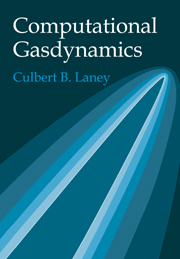Book contents
- Frontmatter
- Contents
- Preface
- Chapter 1 Introduction
- Part I Gasdynamics Review
- Chapter 2 Governing Equations of Gasdynamics
- Chapter 3 Waves
- Chapter 4 Scalar Conservation Laws
- Chapter 5 The Riemann Problem
- Part II Computational Review
- Part III Basic Principles of Computational Gasdynamics
- Part IV Basic Methods of Computational Gasdynamics
- Part V Advanced Methods of Computational Gasdynamics
- Index
Chapter 2 - Governing Equations of Gasdynamics
Published online by Cambridge University Press: 07 December 2009
- Frontmatter
- Contents
- Preface
- Chapter 1 Introduction
- Part I Gasdynamics Review
- Chapter 2 Governing Equations of Gasdynamics
- Chapter 3 Waves
- Chapter 4 Scalar Conservation Laws
- Chapter 5 The Riemann Problem
- Part II Computational Review
- Part III Basic Principles of Computational Gasdynamics
- Part IV Basic Methods of Computational Gasdynamics
- Part V Advanced Methods of Computational Gasdynamics
- Index
Summary
Introduction
The governing equations of gasdynamics are expressions of conservation and the second law of thermodynamics. Conservation requires that three fundamental quantities – mass, momentum, and energy – are neither created nor destroyed but are only redistributed or, excepting mass, converted from one form to another. For example, if momentum increases in one place, either momentum or an equivalent amount of energy must decrease someplace else. Conservation of momentum and energy is extremely complicated for a general physical system owing to the variety of mechanisms that can affect momentum and energy, such as viscosity, chemical reactions, gravity, electromagnetic forces, and so forth. To keep things simple, traditional gasdynamics as discussed in this book concerns inviscid flows of perfect gases, optionally free of forces except for pressure, which eliminates all influences on momentum and energy except for redistribution and pressure.
A companion principle to conservation, known as the second law of thermodynamics, requires that a fourth fundamental quantity called entropy should never decrease. The second law of thermodynamics restricts the redistributions and conversions of conserved quantities otherwise allowed by the conservation laws. As another supplement to conservation, the equations of state specify the nature and type of gas. Three conservation laws, two equations of state, and the second law of thermodynamics collectively constitute the Euler equations when expressed in a fixed coordinate system, or the Lagrange equations when expressed in a coordinate system that moves with the flow. This book mainly concerns the Euler equations, but see Problem 2.7 and Section 23.1 for an introduction to the Lagrange equations.
- Type
- Chapter
- Information
- Computational Gasdynamics , pp. 5 - 20Publisher: Cambridge University PressPrint publication year: 1998
- 2
- Cited by



